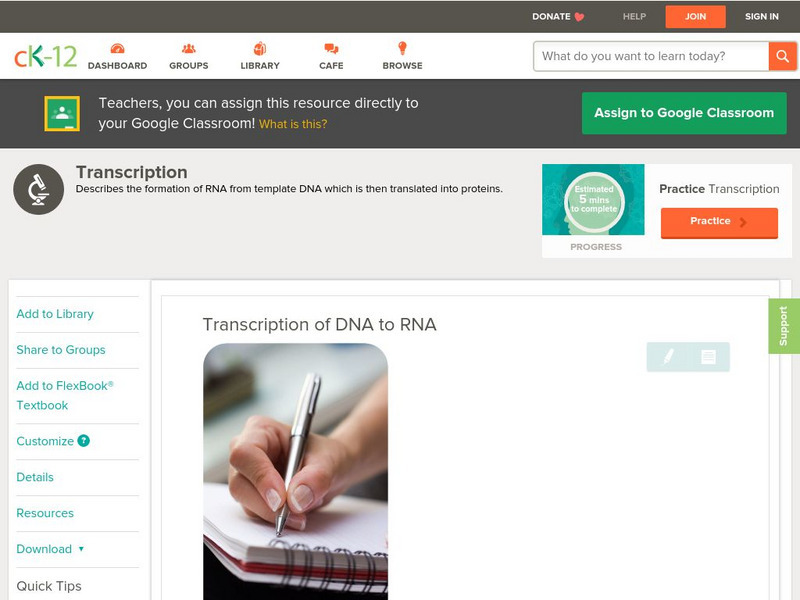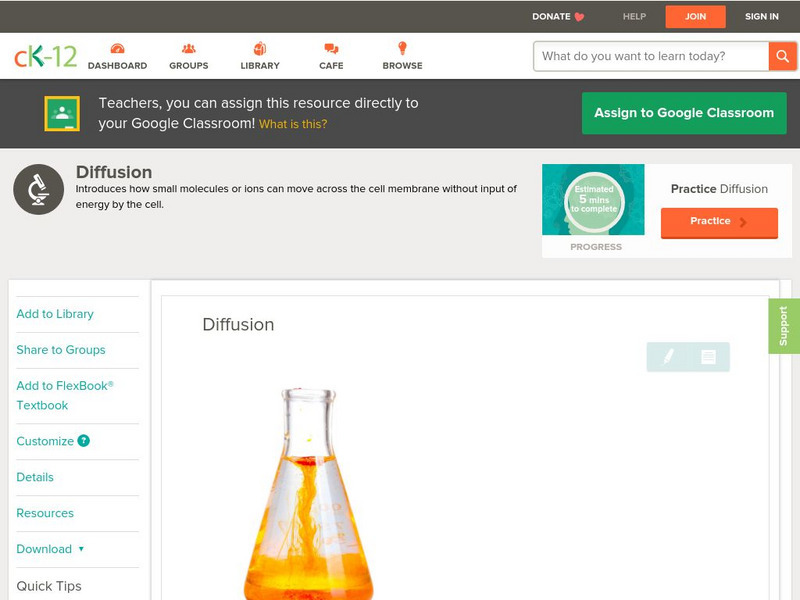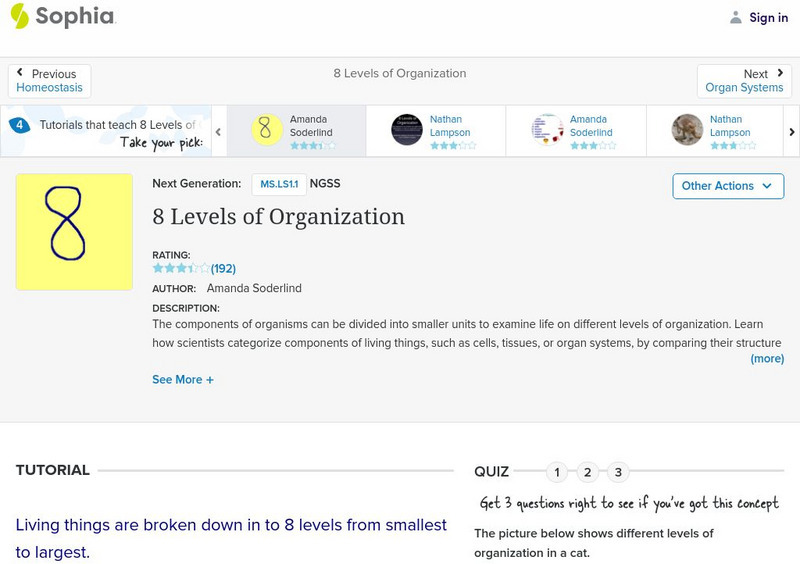Hi, what do you want to do?
CK-12 Foundation
Ck 12: Life Science: Transcription of Dna to Rna
[Free Registration/Login may be required to access all resource tools.] DNA is located in the nucleus. Proteins are made on ribosomes in the cytoplasm. Remember that information in a gene is converted into mRNA, which carries the...
University of Illinois
University of Illinois: The Photosynthetic Process
Site describes process of photosynthesis, including role of pigment molecules, electron transport, ATP synthesis, and carbohydrate synthesis. Includes links to illustrative graphics.
CK-12 Foundation
Ck 12: Life Science: Active Transport
[Free Registration/Login may be required to access all resource tools.] During active transport, molecules move from an area of low concentration to an area of high concentration. This is the opposite of diffusion, and these molecules...
Estrella Mountain Community College
Online Biology Book: Chemistry Ii: Water and Organic Molecules
Online biology textbook discussing the chemical nature of water, and the importance of its molecular structure to life. Also discusses at length the organic molecules nucleic acids, proteins, lipids, and carbohydrates.
CK-12 Foundation
Ck 12: Biology: Water and Life
[Free Registration/Login may be required to access all resource tools.] Covers the structure and properties of water.
CK-12 Foundation
Ck 12: Life Science: Diffusion
[Free Registration/Login may be required to access all resource tools.] The process of molecules moving from an area where there are lots of molecules to an area where there are fewer molecules is known as diffusion. The diffusion of...
Other
My Science Box: Is It Alive?
A lesson plan that introduces middle schoolers to the concept of classifying objects as either living or non-living. From this lesson, students begin to think about the necessary characteristics of life.
CK-12 Foundation
Ck 12: Life Science: Passive Transport
[Free Registration/Login may be required to access all resource tools.] The cell membrane is semi-permeable. Sometimes molecules need the help of special transport proteins or an input of energy to help them move across it. When an input...
CK-12 Foundation
Ck 12: Life Science: Dna Structure and Replication
[Free Registration/Login may be required to access all resource tools.] DNA must replicate (copy) itself so that each resulting cell after mitosis and cell division has the same DNA as the parent cell. DNA replication occurs during the S...
Carnegie Mellon University
Telstar: The Sun and Its Energy
The sun's energy is the primary source of energy for all surface phenomena and life on Earth. Combined with the material of the Earth (including the molecules held close by the Earth's gravitational force called the atmosphere), this...
ArtsNow
Arts Now Learning: Be One With the Water [Pdf]
Fourth graders will explore states of matter and the water cycle by bringing water to life with their bodies. By enacting the changes that water molecules experience, 4th graders will learn scientific information kinesthetically.
TeachEngineering
Teach Engineering: Surfactants: Helping Molecules Get Along
Students learn about the basics of molecules and how they interact with each other. They learn about the idea of polar and non-polar molecules and how they act with other fluids and surfaces. Students acquire a conceptual understanding...
CK-12 Foundation
Ck 12: Biology: First Organic Molecules
[Free Registration/Login may be required to access all resource tools.] Examines how the first organic molecules were formed.
Sophia Learning
Sophia: 8 Levels of Organization: Lesson 2
This lesson will show the 8 levels of organization in living organisms, ranging from smallest to largest. It is 2 of 4 in the series titled "8 Levels of Organization."
Sophia Learning
Sophia: 8 Levels of Organization: Lesson 4
This lesson will show the 8 levels of organization in living organisms, ranging from smallest to largest. It is 4 of 4 in the series titled "8 Levels of Organization."
Sophia Learning
Sophia: 8 Levels of Organization: Lesson 1
This lesson will show the 8 levels of organization in living organisms, ranging from smallest to largest. It is 1 of 4 in the series titled "8 Levels of Organization."
Nobel Media AB
The Nobel Prize: The Nobel Prize in Chemistry 1934
At this website from The Nobel e-Museum, read about Harold Clayton Urey (1893-1981 CE), the chemist awarded with a Nobel Prize "for his discovery of heavy hydrogen." Download Urey's Nobel Lecture, "Some thermodynamic properties of...
Khan Academy
Khan Academy: Biology Foundations: Unit Test
A nine-question unit test over biology foundations along with a review of the chemistry basics to help you understand the beauty of life.
PBS
Pbs Learning Media: Mitosis
This video segment, adapted from the Interactive Secret of Life videodisc, explains the stages of mitosis, the process of dividing equally a cell's massive jumble of DNA just prior to cell division. [1:34]
Soft Schools
Soft Schools: Biochemistry and Organic Chemistry Quiz
Take an interactive quiz over biochemistry and organic chemistry. After completing the quiz, check your score, and then revisit any incorrect question for further review.
Soft Schools
Soft Schools: Dna or Deoxyribonucleic Acid Part Ii Quiz
Take an interactive quiz over DNA. After completing the quiz, check your score, and then revisit any incorrect question for further review.
CK-12 Foundation
Ck 12: Life Science: Carbon Cycle
[Free Registration/Login may be required to access all resource tools.] Carbon is one of the most common elements found in living organisms. Chains of carbon molecules form the backbones of many molecules, such as carbohydrates,...
Carnegie Mellon University
The Sun and Its Energy
The sun's energy is the primary source of energy for all surface phenomena and life on Earth. Combined with the material of the Earth (including the molecules held close by the Earth's gravitational force called the atmosphere), this...
BioMan Biology
Bio Man Biology: Life Chemistry Quizzes
Two multiple-choice quizzes, one on the processes and types of biological molecules, the other on the structure and replication of DNA.

























